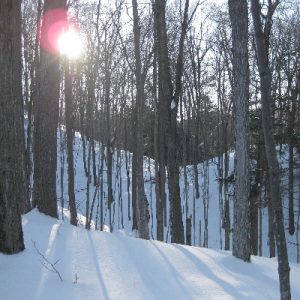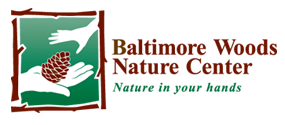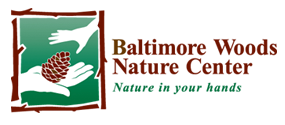Winter Solstice
Week of December 14, 2025 – December 20, 2025
by Anna Stunkel, Environmental Educator
At precisely 10:03 am this morning, did you notice an extra chill to the air? I am just joking; winter solstice isn’t guaranteed to cause more chilliness, but it did take place this morning. Winter solstice is the shortest day and longest night of the year. 10:03 am was the precise moment that the Northern Hemisphere was tilted furthest away from the sun. Although there is plenty of winter weather yet to come, the good news is that days will begin getting longer from this point forward.
Last night, a group of hikers celebrated the solstice with a lantern-lit walk through the forest. This Baltimore Woods tradition happens every year around the solstice, and it is a chance to reflect on the previous year and times to come. Hikers carry kerosene lanterns and walk quietly along the trails (sometimes through the snow), listening to both nighttime sounds and nighttime silence. Winter air can have a certain stillness about it, since snow absorbs sound. Any sounds that do happen cut through the air noticeably. One year, we heard a flock of passing Tundra Swans overhead during the solstice hike.
If you haven’t already, I encourage you to take some quiet time today to reflect on the solstice. For many of us, the holidays are a very busy time. We might be traveling, shopping or making gifts, or thinking about New Years’ resolutions. Meanwhile, animals outside are snuggling into their dens to keep warm and slowing down. While the holidays can be a fun time spent with loved ones, we should also remember that it’s natural for our bodies and minds to want to slow down at this time of year. Although society may move on at the pace of a hummingbird constantly darting from flower to flower, you don’t have to be busy all of the time. After all, there aren’t many flowers blooming in this area right now, but there is a lot of beauty still present in nature. Take a moment to look up at the snow-laced tree branches or listen to an owl hooting. Remember that it is good to rest, and be grateful for the people, other living beings, places, and memories in your life.




We invite our members to enjoy a weekly blog written by our naturalists. Every blog will be uniquely different but always inspired by nature. We may share a memory from a recent hike at The Woods or teach you about an animal or plant that lives on the preserve. No matter the topic, we will be sharing with you our passion for nature and celebrating the connections we all have to the natural world. Each blog will be connected to a weekly set of activities and ideas to help you put nature in your hands, even if you’re at home!


